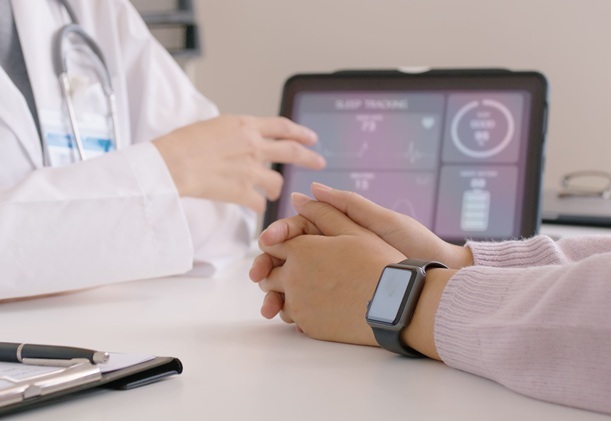Smartwatch Algorithm Detects Cardiac Arrest 
|
By HospiMedica International staff writers Posted on 04 Mar 2025 |

Out-of-hospital cardiac arrest is a critical emergency that demands immediate recognition and response; in cases of sudden, unwitnessed cardiac arrest, survival chances are extremely low. One of the key indicators of cardiac arrest is the sudden loss of a pulse. The use of automated biosensors to detect unwitnessed cardiac arrest and prompt medical assistance could significantly improve survival rates, given the critical role of time in determining outcomes. However, for such systems to be effective, minimizing the false positive burden on emergency medical services is essential. Researchers have now developed an artificial intelligence (AI) system for a smartwatch that can detect signs of cardiac arrest and automatically alert emergency responders. This machine-learning algorithm, partially trained on data from patients whose hearts were intentionally stopped during medical procedures, is capable of recognizing the key indicators of cardiac arrest. While the researchers believe this system could potentially save lives, further testing is necessary to confirm its effectiveness.
The smartwatch algorithm, which leverages machine learning, was developed by Google Research (Mountain View, CA, USA), and is designed to meet performance standards suitable for large-scale use. The researchers first utilized photoplethysmography (PPG) to demonstrate that PPG measurements of peripheral pulselessness (induced by an arterial occlusion model) mirror the signal pattern of pulselessness seen in ventricular fibrillation (VF), a common arrhythmia associated with cardiac arrest. By analyzing the similarity between the PPG signals from VF and those from the occlusion model, they developed and validated a pulse loss detection algorithm using data collected from both the simulated model and real-world conditions.
Once the algorithm was developed, the researchers tested it in real-world scenarios. The results, published in Nature, showed that the system generated one unintentional emergency call per 21.67 user-years across two prospective studies. The algorithm’s sensitivity was 67.23% (with a 95% confidence interval of 64.32%–70.05%) when tested in a simulated arterial occlusion model of cardiac arrest. These findings indicate that this new technology offers a promising solution for wearable detection of sudden pulse loss while minimizing the societal impact of false alarms.
Latest Health IT News
- Printable Molecule-Selective Nanoparticles Enable Mass Production of Wearable Biosensors
- Smartwatches Could Detect Congestive Heart Failure
- Versatile Smart Patch Combines Health Monitoring and Drug Delivery
- Machine Learning Model Improves Mortality Risk Prediction for Cardiac Surgery Patients
- Strategic Collaboration to Develop and Integrate Generative AI into Healthcare
- AI-Enabled Operating Rooms Solution Helps Hospitals Maximize Utilization and Unlock Capacity
- AI Predicts Pancreatic Cancer Three Years before Diagnosis from Patients’ Medical Records
- First Fully Autonomous Generative AI Personalized Medical Authorizations System Reduces Care Delay
- Electronic Health Records May Be Key to Improving Patient Care, Study Finds
- AI Trained for Specific Vocal Biomarkers Could Accurately Predict Coronary Artery Disease
Channels
Surgical Techniques
view channel
New Transcatheter Valve Found Safe and Effective for Treating Aortic Regurgitation
Aortic regurgitation is a condition in which the aortic valve does not close properly, allowing blood to flow backward into the left ventricle. This results in decreased blood flow from the heart to the... Read more
Minimally Invasive Valve Repair Reduces Hospitalizations in Severe Tricuspid Regurgitation Patients
The tricuspid valve is one of the four heart valves, responsible for regulating blood flow from the right atrium (the heart's upper-right chamber) to the right ventricle (the lower-right chamber).... Read morePatient Care
view channel
Portable Biosensor Platform to Reduce Hospital-Acquired Infections
Approximately 4 million patients in the European Union acquire healthcare-associated infections (HAIs) or nosocomial infections each year, with around 37,000 deaths directly resulting from these infections,... Read moreFirst-Of-Its-Kind Portable Germicidal Light Technology Disinfects High-Touch Clinical Surfaces in Seconds
Reducing healthcare-acquired infections (HAIs) remains a pressing issue within global healthcare systems. In the United States alone, 1.7 million patients contract HAIs annually, leading to approximately... Read more
Surgical Capacity Optimization Solution Helps Hospitals Boost OR Utilization
An innovative solution has the capability to transform surgical capacity utilization by targeting the root cause of surgical block time inefficiencies. Fujitsu Limited’s (Tokyo, Japan) Surgical Capacity... Read more
Game-Changing Innovation in Surgical Instrument Sterilization Significantly Improves OR Throughput
A groundbreaking innovation enables hospitals to significantly improve instrument processing time and throughput in operating rooms (ORs) and sterile processing departments. Turbett Surgical, Inc.... Read moreHealth IT
view channel
Printable Molecule-Selective Nanoparticles Enable Mass Production of Wearable Biosensors
The future of medicine is likely to focus on the personalization of healthcare—understanding exactly what an individual requires and delivering the appropriate combination of nutrients, metabolites, and... Read more
Smartwatches Could Detect Congestive Heart Failure
Diagnosing congestive heart failure (CHF) typically requires expensive and time-consuming imaging techniques like echocardiography, also known as cardiac ultrasound. Previously, detecting CHF by analyzing... Read morePoint of Care
view channel
Handheld, Sound-Based Diagnostic System Delivers Bedside Blood Test Results in An Hour
Patients who go to a doctor for a blood test often have to contend with a needle and syringe, followed by a long wait—sometimes hours or even days—for lab results. Scientists have been working hard to... Read more
Smartphone-Enabled, Paper-Based Quantitative Diagnostic Platform Transforms POC Testing
Point-of-care diagnostics are crucial for public health, offering rapid, on-site testing that enables prompt diagnosis and treatment. This is especially valuable in remote or underserved regions where... Read moreBusiness
view channel
Expanded Collaboration to Transform OR Technology Through AI and Automation
The expansion of an existing collaboration between three leading companies aims to develop artificial intelligence (AI)-driven solutions for smart operating rooms with sophisticated monitoring and automation.... Read more


















